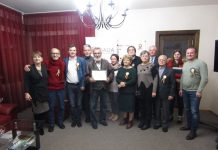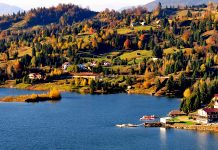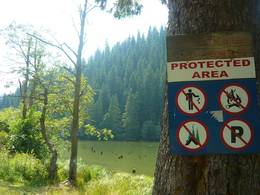 Romania is a great country to discover- and we’re not just saying that because some of us here are Romanians. Some places in the country are already well-known, mainly because they are better promoted, but many other places remain unknown. We’ve dig up 40 such places for those who want to discover the not-so-well-known places in Romania. Here they are below. If you’re found something else interesting that is not on our list, drop us a line.
Romania is a great country to discover- and we’re not just saying that because some of us here are Romanians. Some places in the country are already well-known, mainly because they are better promoted, but many other places remain unknown. We’ve dig up 40 such places for those who want to discover the not-so-well-known places in Romania. Here they are below. If you’re found something else interesting that is not on our list, drop us a line.
Check out the map below to see the counties of Romania where these places can be found.
1. Living Fires in Lopatari, Buzau County
The Living Fires (Focurile Vii in Romanian) can be found in the Romanian village of Lopatari, Buzau County, in Slanicului Valley, 56 km away from Buzau city. Living Fires can be as high as 20 cm and represent a natural phenomenon unique in Europe. They are blue flames burning in places where the soil is cracked and kept alive because of the gas that comes to surface.
2. Muddy Volcanoes, Buzau County
You might have recently heard about this one, but it is not as well known as it would deserve. The Muddy Volcanoes are located in Buzau County, in Paclele area, in the village of Berca. The Muddy Volcanoes are miniature craters which are formed because of the natural gas that comes from a depth of more than 3000 m. It lies on about 30 hectares and is a unique phenomenon in Romania, also rare in the world.
3. Ochiul Beiului Lake, Caras- Severin County
Ochiul Beiului Lake, with water that has a green-blue color, is in the village of Sasca Montana, in Caras-Severin County. From Bucharest, the lake can be reached easily by following the route Bucharest – Pitesti – Slatina – Craiova – Filiasi – Drobeta Turnu Severin – Orsova – Moldova Noua – Sasca Montana, with a length of 509 km. What’s interesting about this place is that the lake’s water doesn’t freeze even at extremely low temperatures during winter, because of the spring that feeds permanently the lake with water.
4. Ruins of Roman Porolissum, Salaj County
One of the best preserved archaeological sites in Romania is called Porolissum, an old Roman city. Besides its impressive size, the site also had has a good conservation during the centuries. Castrul Roman Porolissum can be found in Salaj County, in Mirsid.
5. Vidra Lake, Valcea County
The Vidra Lake is a men-made lake, dating from 1972. The lake is 30 km away from Voineasa resort in Valcea County, between Lotrului, Latoritei rivers and Capatanii Mountains. This place can offer some really great moments to those who love nature, through its silence, fresh air and great green forests that are surrounding the lake.
6. The Church under the lake, Cluj County
Although hidden from human eyes most of the time, the Church under the lake from Belis, in Cluj county, comes out during the hot, low-rainfall summers. Belis is a village in Transylvania, at an altitude of 1,000 m, in Gilau Mountains. Only in the days of hot summer the old ruins of the church, dating from the nineteenth century, come out of the water. Equally impressive are the paintings that decorate the ruins, embodying angels and biblical scenes.
7. The Bears’ Cave – Ursilor cave, Bihor County
Known as one of the most spectacular sights of the Romanian Apuseni Mountains, the Bears’ Cave is located near Chiscau, in Bihor County, at an altitude of 482 meters. The cave’s name comes from the many cave bear fossils discovered there, as this place was a favorable place of shelter for animals around 15,000 years ago. There are around 547 km between Bucharest and the Bears’ Cave, a distance that can be covered by car in about 7 hours.
8. The Merry Cemetery, Maramures County
The Romanian village of Sapanta, in Maramures County, became famous for its Merry Cemetery that has become a very important tourist attraction. The cemetery’s name comes from the colorful crosses and the satirical poetry that is written on them. After the cross is carved, it is usually painted in blue, the so-called “Blue Sapanta”. The distance between Bucharest and Sapanta is about 600 km.
9. Comana Natural Park, Ilfov County
Comana Natural Park, 35 km away from Bucharest, is unique in Europe, and includes dozens of species of plants and animals protected by the international laws, being considered the second Delta of Romania, after the Danube Delta. The natural park covers 25,000 hectares, being the largest protected area in the Romanian Plain (Campia Romana).
10. The steam train in Viseul de Sus, Vaserului defile (Mocanita), Maramures County
Vaserului Gorge, with the appearance of a canyon, is located in the eastern part of the Maramures Mountains. Tourists can travel through the entire gorge using one of the few steam trains in Romania, “Mocanita de la Viseul de Sus”, that departs daily from Viseul de Sus village, reaching Novat, Faina and even Macarlau. The distance between Viseul de Sus and Bucharest is 523 km.
11. Red Lake (Lacul Rosu), Harghita County
The Red Lake is a natural lake that was created when half of a mountain fell. It is situated in Hasmasu Mare Mountains, near the town of Gheorgheni, Harghita County, 323 km away from Bucharest. This is the largest natural mountain lake in Romania. Its name came from the Red River, that crossing red layers, with iron oxides and hydroxides. The lake appears dark and threatening. The trees that were swallowed by the water, which now appear on the surface give the impression of strange and mysterious.
12. Neamtului Fortress, Neamt County
You might have heard of the Neamtului Fortress once or twice before, as it has been recently renovated and might have had more promotion lately. It is a medieval citadel situated in Moldova, near the town of Targu Neamt, at about 46 km from the city of Piatra Neamt, and 398 km from Bucharest. Located near the highest point of the Plesului Peak, the city is part of the medieval monuments with an exceptional value in Romania. Read more about it here (in Romanian).
13. Fagaras Fortress, Brasov County
Fagaras Fortress is the most imposing monument in the region, in Fagaras city, Brasov County, at about 235 km from Bucharest. It is one of the largest and best preserved in the whole country, and even in Europe. Fagaras Fortress appeared for the first time in official documents in 1455, but its construction has started since the late fourteenth century.
14. The living stones, Costesti, Valcea County (Pietrele Vii)
Near the road linking Targu Jiu with Ramnicu Valcea, in the Costesti village, nature has created some of the most amazing stone carvings called “the living stones”. With bizarre shapes, millimeter, or man-sized, the stones continue to emerge as people exploit the sand. These works of nature are some stones with supernatural origins, as locals say. The “living stones” are also called “the stones that grow”. This strange stones can be found at about 130 km from Bucharest.
15. Cave Churches in Buzau – Chilia lui Dionisie Torcătorul, Buzaului Mountains, Buzau County
Nucu village in Buzau County is an old place, full of mystery. Who dares to walk on the mountain roads has the opportunity to meet the most important cave complex in Buzau Mountains. Caves, cells and churches carved in stone during the first centuries of Christianity, were used as places of refuge and worship. One of the cells belonged to the monk Dionisie, who, the legend says, made the road to his cell as complicated as possible, because he liked to be alone.
16. Hunedoara Fortress, Hunedoara County
Hunedoara Fortress, also called Corvinilor Castle, is the most important monument of Gothic architecture in Transilvania, Romania. The monument in Hunedoara is representative for the military architecture in South-East Europe, from the fifteenth century. Other elements that make Hunedoara Fortress unique are further intervention made in the fifteenth century, which offers a mixture of unique architectural elements belonging to the Renaissance, Baroque and Gothic styles. The distance between Bucharest and Hunedoara is of about 390 km.
17. Cetatuita Negru Voda Monastery, Arges County
Cetatuia Negru Voda Monastery is located at 880 meters altitude, between Chiliilor Valley, Coman Valley and the water of Dambovita, 25 km south of Campulung city. The monastery is located in a natural cave, where a small, beautiful fountain can be found. To go there from Bucharest, you have to drive for 153 km.
18. Turda Salt Mine, Cluj County
The Salt Mine in Turda, that can be found in the city of Turda, Cluj County, is a veritable history museum of salt mining. The excellent state of preservation of mining and machinery used to transport salt, together with the cautious work carried out for preparing the mine, turned the Turda Salt Mine into a tourist attraction. To get to Turda, you have to go 410 km from Bucharest.
19. Tihuta Clough
Tihuta Clough, located 473 km away from Bucharest, has a high degree of difficulty in terms of crossing it, as it is crossed by one of the toughest roads located in the mountains in Europe. Access to the Tihuta Clough is made through the E576 (DN17), the road linking the cities of Suceava and Bistrita. The landscape in the area looks like untouched by man, which makes it an ideal place for relaxation. Too see live images from the Tihuta Clough, go here.
20. The Seven Stairs Canyon & the Tamina Cascade, Brasov County
The Seven Stairs Canyon’s route is accessible to all nature lovers and represents a good alternative for a day out. The canyon is in the central-west side of Piatra Mare Mountains, at an average altitude of 980 meters. The first so-called ‘step’ of the cascade, from the bottom up, has a height of 8 meters, followed by another 6 such steps, most of them being over 35 meters high. The Seven Stairs Canyon is at about 165 km from the capital city.
21. The Racos basalt columns and the extinct volcano, Brasov County
Racos is a village far away from the main road linking Brasov to Sighisoara, the village where you can see a volcano that didn’t erupt in hundreds of years. Once you arrive in this place, you have the feeling that you are on Mars, because of the red landscape. The geological site from Racos includes spectacular post eruption scenery of 10-15 meters high, formed by the rapid cooling of lava. There are around 250 km from Bucharest until Racos village.
22. Cacica salt mine, Suceava County
Cacica Salt Mine is located in the village of Cacica, in Suceava County, 450 km from Bucharest, and is unique through its 8,200 hand-dug galleries, without machines. The galleries are in a very good condition today. At 192 steps down to 27 meters deep is the St. Varvara Roman Catholic Chapel, while at 35 meters deep, there is an Othodox Chapel. There is also a Salt Lake, an artificial lake dug manually by miners.
23. Fairies’ Fortress, Covasna County
The Fairies’ Fortress is an ancient Dacian fortress situated on a mountain peak near the city of Covasna. Walls found by archaeologists during excavations are currently visible. The road to the fortress takes about 2 hours on some unmarked forest roads. Research conducted there revealed numerous fragments of pottery and coins dating from the Dacian and Roman age. The distance from Bucharest to the city of Covasna is 227 km.
24. The Sinca Veche Rupestral Monastery in Brasov County
The Sinca Veche Monastery, actually an underground temple, is situated next to Plesu Hills, in the Romanian Sinca Veche village in Brasov County, 220 km from Bucharest. It is said that the monastery was built thousands of years ago, in the Dacian times or even before. The monastery is cut entirely in stone and has 2 altars and 9 rooms filled with curious statues, like the Yin-Yang symbol or the David’s star. The tower is made out of soft sandstone and has no roof, which allows the sun to shine on the altar.
25. Piramids from Sona in Fagaras, Brasov County
The Pyramids from Sona are actually eight mounds of earth, 30 meters high, that seem to come out of nowhere. While locals are convinced that they were raised by giants, historians believe that there are graves of Celtic barbarians. The legend says that many years ago, this land was ruled by a princess named Sona. One day her kingdom was attacked by some giants who came over the Fagaras mountains. The giants have gone through the water of Olt river, and when they arrived in this place they shook the mud from their feet and created these mounds. You can find them in Sona village, Brasov County, 250 km away from Bucharest.
26. Gura Portitei in the Danube Delta, Tulcea County
To get to Gura Portitei, you have to drive almost 300 km on the road from Bucharest to Jurilovca, further having to take a passenger ship or a motorboat to cross the Golovita waters. Gura Portitei is a perfect place for those who enjoy peace, fresh air, crystal clear water, and open space. There is also a wide range of recreation facilities, from daily trips on the Danube channels to renting rowboats, motorboats, hydro bikes, ski jets, tennis and volley grounds.
27. Polovragi Cave in Gorj County
Polovragi Cave is 11 km long, and has 800 m with electric light since 1984. The water that drops continually from cave’s ceiling forms stalactites and stalagmites, but also clay so you have to watch your steps. Hazard and time created bizarre limestone formations which received poetic names: Lotus, The Throne of Zalmoxis, The Monk. Between Bucharest and the Polovragi Cave there is a distance of 243 km.
28. Bicaz Canyon, Neamt & Harghita Counties
The Bicaz Canyon, (Cheile Bicazului in Romanian), is one of the most spectacular places in Romania, located in the north-east part of the country, in Neamt and Harghita counties, 372 km from Bucharest. The canyon was dug by the waters of Bicaz River and it serves as a passageway between the Romanian provinces of Moldova and Transylvania. The road along the 8 kilometers of ravines, often in serpentines with rock on one side and a sheer drop on the other, is one of the most spectacular drives in the country.
29. Scarisoara Cave – the glacier, Alba County
Situated in the Apuseni Mountains, almost 40 km away from the town of Campeni, in the North-Western part of Alba County, in the village of Garda de Sus, Scarisoara Cave is one of the largest ice caves in Romania. Declared a natural monument and a speleological reservation, the cave is famous for its glacier that is older than 3,000 years. To get there from Bucharest, you have to drive around 480 km.
30. Petresti Fortress, Alba County
The Petresti Fortress, built by Saxons is a historical fortress, where the Saxons throughout Romania return to celebrate their past in Alba Iulia. It is located out of Petresti village, next to the Sebes river, at around 350 km from Bucharest. From the old fortress, the wall and the ruins of the bell tower are still standing.
31. Grohot Natural Bridge, Hunedoara County
The Grohot Bridge can be appreciated by its greatness as one of the most spectacular karst phenomena in the Apuseni Mountains. This is very interesting in its morphological features, through the beautiful landscape, and the great vegetation. The distance between Bucharest and this place is about 490 km.
32. God’s Bridge, Baia de Arama in Mehedinti County
Ponoarele is a village located in Mehedinţi County, Oltenia, Romania, at about 335 km from Bucharest. Here one can find a natural monument named God’s Bridge, a natural bridge formed when the ceiling of a cave had collapsed. The bridge is actually a 4 m thick rock arch, with an opening of 25 m and a length of 50 meters. The legend says that the Devil lived in Ponoarele Cave. The locals asked God to chase him, and God hit with His palm the cave ceiling, which collapsed and blocked the cave’s entrance. But the Devil escaped by the other mouth of the cave and climbed the Devil’s Rock, a place from where he guards the people who enter in the cave and sometimes he drowns them in the Zatonul Mare lake.
33. Jiu, Mures, Cris and Olt Valleys – for rafting
If you like rafting, you have to try that on the most spectacular rafting area in Romania, Jiului Valley, between the city of Livezeni and Bumbesti Jiu. The route is about 25-30 km, and optional, by request, you can make rafting at night, and a picnic in nature. To get there from Bucharest you have to do around 350 km. Rafting can also be done on Mures, Cris and Olt valleys.
34. Stone Ravens Monastery, Arges County
The Corbii De Piatra (The Stone Ravens) monastery is a Romanian monastery located in the Jgheaburi village, in Arges county, in the heart of a mysterious and very ancient ascetic Romanian settlement. The monastery’s church is carved into the rock, and appears in documents with this name from its reestablishment in 1512. Find more about it here: http://www.corbiidepiatra.ro/
35. Transalpina road, Gorj, Valcea, Sibiu & Alba Counties
Also called the “King’s Road”, Transalpina is the road that connects Oltenia region and Transylvania. It is the highest altitude road in Romania that can be crossed from one end to another by car. It’s not yet sure why this road was build but the local legend says it was built by the German people during World War I, just for military purposes. Transalpina can be covered in about 3-4 hours on the trail Sebes, Sugag, Obarsia Lotrului, Ranca, Novaci.
36. Ciucas Waterfall in Cluj County
Located about 55 km from Cluj Napoca, Ciucas Waterfall is one of the most important tourist attractions of Cluj County. Ciucas Waterfall has a height of only 5 meters, and behind it lies a small lake where the water accumulates. The distance between this place and Bucharest is about 500 km.
37. Capra Lake, Fagaras Mountains, Brasov County
Well hidden in the heart of Fagaras Mountains, Capra Lake, a glacial lake, is situated at an altitude of 2,241 meters. The lake impresses with its blue water and makes a great place for those who love nature and mountains, through its landscape. To get there from Bucharest, you have to drive around 250 km, a trip that will take about 3 hours.
38. Fortified Church in Viscri , Brasov County
The Fortified Church in Viscri is one of the representative buildings in Brasov. Built in a Gothic style, it is located 7 km from Dacia village, Brasov County, and about 240 km away from the capital city. Beside the church, which is a real fortress, a unique collection exhibited at the ethnographic museum can be seen here. It presents the objects truly representative for people’s everyday life, traditions and customs in the area.
39. The Siriu Dam, Buzau County
The Siriu Dam opens in front of visitors as a boundless expanse of water. Siriu Lake is a man-made lake, located on the upper part of Buzaului river. Siriu Dam is a great destination for fishermen, who can find trout here. The Siriu village is located in the North-East part of the Buzau County, at about 164 km from Bucharest.
40. Bats’ Cave, Brasov County
Also known as the Cave with Bats, the Great Cave, the Bats’ Cave is the home for rare species of bats. The cave also has a great historical significance for people, giving the name of the village, Pestera village (in Romanian ‘Cave village’). Situated at an altitude of 950 meters, on the Bran platform in Pestera village, the cave is reported in various documents since centuries ago. To get there from Bucharest, you have to drive for around 180 km.
irina.popescu@romania-insider.com Copyright © 2011 — Romania Business Insider











































